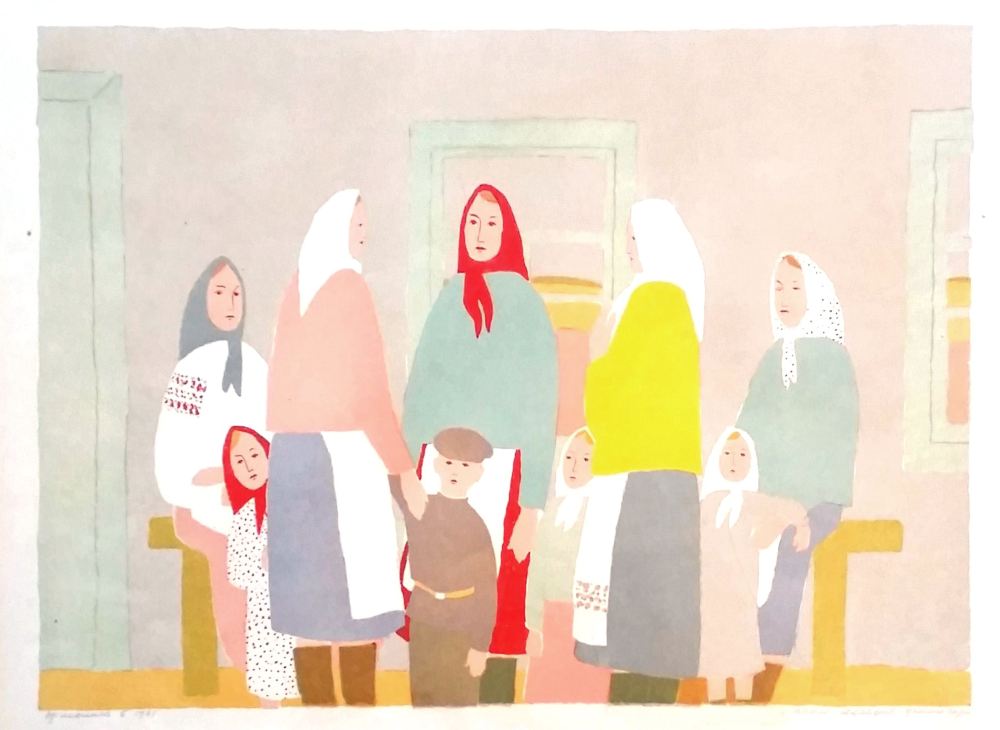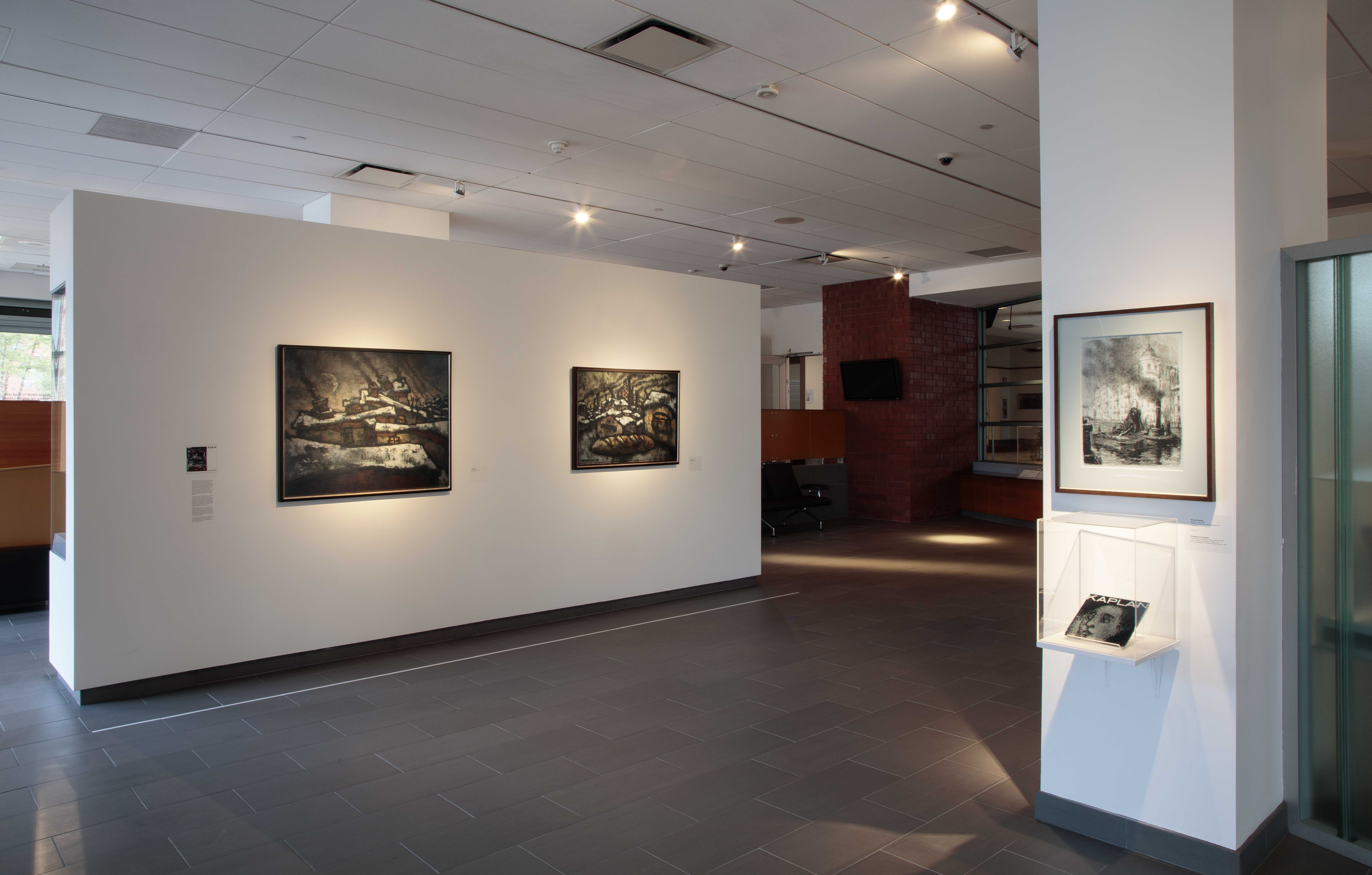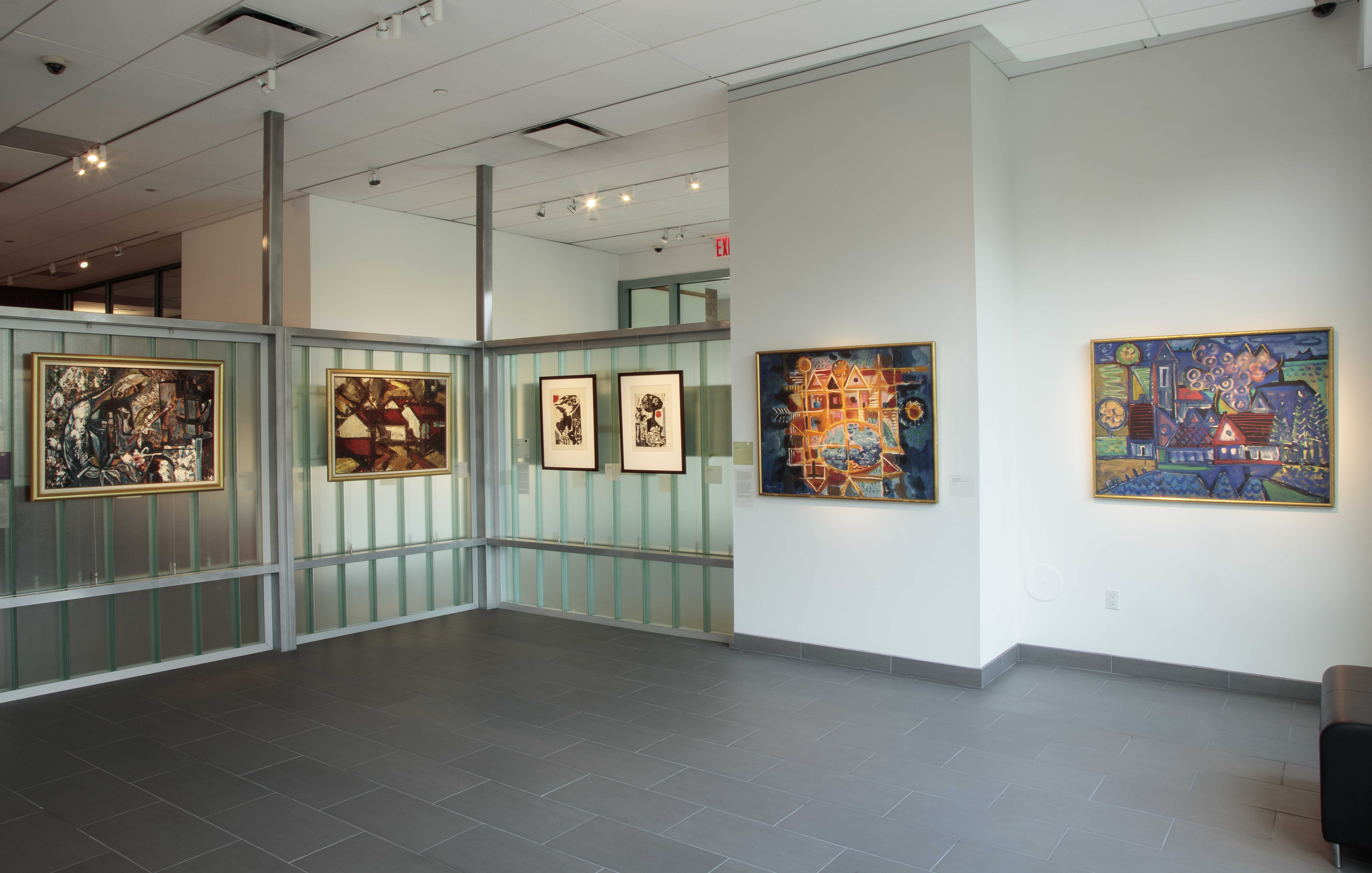From the Eastern Bloc to the Bronx: Early Acquisitions from the Art Collection
From the Eastern Bloc to the Bronx: Early Acquisitions from the Art Collection, Derfner Judaica Museum and the Art Collection at the Hebrew Home, Riverdale, New York (May 5-August 25, 2019)
Writing in 2009, Polish scholar Piotr Piotrowski suggested that we recognize multiple, coexisting art historical canons. Focusing on the postwar period, Piotrowski sketched out a series of interweaving histories, at once looking at the broader picture while also considering the political heterogeneity of specific states within the Soviet-dominated region.(See Piotr Piotrowski, In the Shadow of Yalta: Art and Avant-Garde in Eastern Europe, 1945-1989 (London: Reaktion Books, 2009). ) Piotrowski’s book, In the Shadow of Yalta, became a landmark publication on modern Eastern and Central European art, although it notably overlooked the art made during the Stalinist period (1949-1956) and the subsequent history of Socialist Realism.(While Joseph Stalin died in 1953, I refer to the Stalinist period in art historical terms. As such, I understand it as the time between the imposition of Socialist Realism across the Soviet satellite states in 1949 and Khrushchev’s de-Stalinizing speech in 1956, which ushered the region into the period of cultural thaw. ) Positioning the postwar avant-garde as a reaction to the trauma of the Socialist Realist past, Piotrowski did not recognize the need to locate the aforementioned multiplicity of canons beyond the history of the Central and Eastern European avant-garde movements. Over the last decade or so, scholars in both East and West became increasingly engaged in productively disrupting these traditionally established binaries of modernism vs. totalitarianism, in turn revealing the conceptual as well as the stylistic complexity of art made even during the Stalinist period.(See Jérôme Bazin, Réalisme et égalité. Une histoire sociale de l’art en République démocratique allemande (1949-1990) (Dijon: Les Presses du réel, 2015); April Eisman, Bernhard Heisig and the Fight for Modern Art in East Germany (Rochester, NY: Camden House, 2018); Murawska-Muthesius, Katarzyna. “How the West Corroborated Socialist Realism in the East: Fougeron, Taslitzky, and Picasso in Warsaw,” Biuletyn Historii sztuki 65, no. 2 (2003); Michael Tymkiw, Nazi Exhibition Design and Modernism (Minneapolis: University of Minnesota Press, 2018.)

Exhibition view of From the Eastern Bloc to the Bronx: Early Acquisitions from the Art Collection, Derfner Judaica Museum and The Art Collection at The Hebrew Home, Riverdale, New York. Photo courtesy of The Hebrew Home.
Among the more recent efforts to expand our historical perspectives on post-1945 Central and Eastern European art was the exhibition From the Eastern Bloc to the Bronx: Early Acquistions from the Art Collection, curated by Emily O’Leary at the Derfner Judaica Museum and the Art Collection at The Hebrew Home in Riverdale, New York. Arguably, the Derfner Museum, which belongs to the Hebrew Home—a sprawling elderly care facility located by the Hudson River—is not a well-known cultural institution. With a small curatorial staff and modest exhibition space, its primary focus remains on safekeeping its collection (which includes important Judaica artifacts), and making it accessible to both the Hebrew Home’s resident population and the general public. From the Eastern Bloc to the Bronx brought together paintings, drawings, and prints by thirty-five artists active primarily during the 1950s and 1960s in four Soviet-dominated countries—the Soviet Socialist Republic of Armenia, the USSR, Hungary, and Czechoslovakia. All of these works were first shown in nine exhibitions of Eastern European art held between 1961 and 1967 at the Grosvenor Gallery in London and the curators at the Derfner grouped them according to the original Grosvenor displays and providing facsimiles of the 1960’s exhibition catalogs.
In theory, displaying works through the lens of a Western collector working in London at the height of the Cold War can be historically and visually engaging, although the rather idiosyncratic exhibition space of the Derfner is not well suited for this type of presentation. Taking up several walls, the exhibition was tucked in amongst works from the Judaica collection placed on permanent view (among the plethora of Judaic objects owned by the museum are an elaborately carved silver Hanukkah lamp made between 1750 and 1760, a nineteenth-century silver Kiddush cup, and a pair of early twentieth-century Mikveh clogs made out of wood with inlaid mother-of-pearl), resulting in a confusing curatorial setup.
The physical limitations of the museum’s exhibition space, however, were more than rectified by the works on view. The objects featured in the show were acquired by the museum in the 1970s through a collaborative effort between the Grosvernor’s Eric Estorick (his father, who suffered from Alzheimer’s disease, was a resident of the facility), and Hebrew Home’s then-director Jacob Reingold. The many prints, posters, paintings, and drawings exhibited established a series of parallel art histories of an ethnically diverse geographic region, one that was torn apart by war only to be swiftly dominated by a totalitarian regime. A forlorn industrial landscape made in 1963 by non-conformist Russian artist Oscar Rabin, for example, is juxtaposed with a lyrical self-portrait by the Hungarian Mihály Schéner painted in 1964. Tethered by the political domination of the Soviet Union, they each shine a spotlight on a distinctive sociocultural milieu, revealing in turn a wide landscape of stylistically and ideologically diverse artistic activities.
The majority of the works exhibited were made after the 1956 cultural Thaw, but—as Piotrowski would remind us—visual cultures of Eastern and Central European countries were affected by the Thaw in dissimilar ways. In some cases, as with Czechoslovakia, the ideological stronghold of Socialist Realism officially remained in place longer than it did, for example, in Poland. One of the major contributions of the Derfner exhibition—to the extent of its scale—was that it allowed the viewer to experience these art historical non-synchronicities, while also illuminating the inherent ideological ambiguity of the official cultural agenda prescribed by the Soviets.

Boris Ermolaev (Russian, 1903–1982), At School on the Eve of the School Year, 1961, lithograph, 17 x 23 inches, HHAR 1513 ® Derfner Judaica Museum and The Art Collection at The Hebrew Home, Riverdale, New York.
The section devoted to Soviet printmakers from the Leningrad Experimental Graphics Laboratory (LEGL) offered an apt example, as it included a number of graphic works seemingly made in accordance with the propagandism of the Artists’ Union (to which all LEGL members had to belong). Boris Ermolaev’s print At School on the Eve of the School Year (1961), for instance, addresses an officially sanctioned subject matter of countryside education. And yet, the composition is more puzzling than it is propagandistic. Utilizing flat color planes and a pastel-like palette, the image depicts peasant women and children devoid of any enthusiasm and appears more reminiscent of Kazimir Malevich’s wonderfully enigmatic peasant compositions from the 1920s, than of a work one would associate with the didacticism of the Socialist Realist doctrine.

Exhibition view of From the Eastern Bloc to the Bronx: Early Acquisitions from the Art Collection, Derfner Judaica Museum and The Art Collection at The Hebrew Home, Riverdale, New York. Photo courtesy of The Hebrew Home.
Exhibited on the other side of the room was a series of prints by the Slovak artist Vincent Hložník titled Dreams (1962), which bears clear visual resemblance to the fragmented and neurotic vocabulary of Pablo Picasso’s 1937 Guernica, yet seems devoid of any political content. These distinctly personal works depict disjointed parts of human bodies and animals in a claustrophobic, surrealistic space. Both are made in a primarily monochromatic color palette, disrupted only by a few abstract shapes of red and blue. According to the exhibition catalog, Hložník, who was the head of the Department of Graphic Art and Illustration at the Bratislava Academy of Fine Arts between 1952 and 1972, was not considered a “dissident” artist. One wonders, then, about the kind of ideological commitment his Dreams series reflects and the ways in which Hložník managed to negotiate his central position in the country’s postwar art scene. Remarkably, the time he spent at the academy was bracketed by dates that marked periods of intense political oppression—1952 was in the very middle of the Stalinist regime and 1972 was the year during which the process of communist “normalization,” following the 1968 Czech Spring, was consolidated. While explicit politics are hard to find in the Dreams series, the ending date of his tenure at the academy may suggest that, at a moment when the government cracked down on the country’s contemporary politics and culture, even such ideologically abstruse art was no longer accepted.

Exhibition view of From the Eastern Bloc to the Bronx: Early Acquisitions from the Art Collection, Derfner Judaica Museum and The Art Collection at The Hebrew Home, Riverdale, New York. Photo Courtesy of The Hebrew Home.
The first acquisition the Hebrew Home made from the Grosvenor Gallery in 1975 consisted of works by two Jewish artists, Anatoli Kaplan and Solomon Gershov. Kaplan’s Yiddish-themed print series The Little Goat, made between 1958 and 1961 and included in the exhibition, offers a new take on stories by Sholem Aleichem. Originally shown in London in a 1961 exhibition titled Anatoli Kaplan: The World of Sholem Aleichem and Other Scenes, Tales and Songs of Russian Provincial Life, these compositions appear oddly anachronistic, capitalizing on vernacular Jewish imagery, text, and abstract ornaments all depicted using a subdued color palette. With lettering in both Yiddish and Cyrillic, Kaplan’s work may also be read as an historical nod towards the Jewish Renaissance in Russia, a period extending from the late nineteenth to the early twentieth centuries during which Jewish culture blossomed. More importantly, Kaplan’s work, made in the aftermath of the Holocaust, also points to a continued relevance of Jewish culture in shaping the postwar art of Eastern Europe. Augmenting their distinct cultural identity were numerous Judaica treasures—including elaborately decorated menorahs—displayed in the same room and on permanent view at the Derfner.
Many of the artists exhibited in From the Eastern Bloc to the Bronx led long and prosperous careers—the Armenian painter Mariam Aslamazian, author of radiant yet enigmatic Socialist Realist still lifes, and Oscar Rabin, whose prolific oeuvre is exemplified here by the aforementioned crude landscapes of Russian towns, for instance—and it is regrettable that the show was not accompanied by a more comprehensive catalog. To complement each of the displays by a reproduction of the corresponding Grosvenor Gallery publication from the 1960s was an informative strategy, although the actual exhibition catalog (published online and authored entirely by the exhibition curator) falls short of sufficiently addressing the complex geopolitics of the region and their relationship to the work on view.
While the catalog would doubtless benefit from focused scholarly essays, From the Eastern Bloc to the Bronx, highlighting and probing the heterogeneous nature of postwar Eastern and Central European art, was still a worthy and revealing contribution to the rapidly emerging art historical field focusing on the post-1945 art of the region. Exhibiting works rarely been seen by the Western public, it set out to tell the many histories of the Soviet-aligned postwar states and, in its own way, heeded to Piotrowski’s call for a multiplicity of canons.




